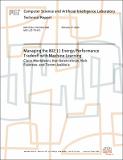Managing the 802.11 Energy/Performance Tradeoff with Machine Learning
Author(s)
Monteleoni, Claire; Balakrishnan, Hari; Feamster, Nick; Jaakkola, Tommi
DownloadMIT-CSAIL-TR-2004-068.ps (22.13Mb)
Additional downloads
Other Contributors
Networks and Mobile Systems
Metadata
Show full item recordAbstract
This paper addresses the problem of managing the tradeoff betweenenergy consumption and performance in wireless devices implementingthe IEEE 802.11 standard. To save energy, the 802.11 specificationproposes a power-saving mode (PSM), where a device can sleep to saveenergy, periodically waking up to receive packets from a neighbor(e.g., an access point) that may have buffered packets for thesleeping device. Previous work has shown that a fixed polling time forwaking up degrades the performance of Web transfers, because networkactivity is bursty and time-varying. We apply a new online machinelearning algorithm to this problem and show, using ns simulation andtrace analysis, that it is able to adapt well to network activity. Thelearning process makes no assumptions about the underlying networkactivity being stationary or even Markov. Our learning power-savingalgorithm, LPSM, guides the learning using a "loss function" thatcombines the increased latency from potentially sleeping too long andthe wasted use of energy in waking up too soon. In our nssimulations, LPSM saved 7%-20% more energy than 802.11 in power-savingmode, with an associated increase in average latency by a factor of1.02, and not more than 1.2. LPSM is straightforward to implementwithin the 802.11 PSM framework.
Date issued
2004-10-27Other identifiers
MIT-CSAIL-TR-2004-068
MIT-LCS-TR-971
Series/Report no.
Massachusetts Institute of Technology Computer Science and Artificial Intelligence Laboratory